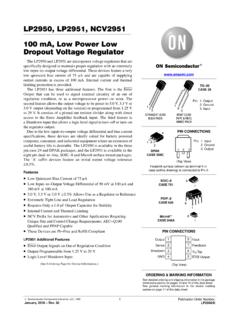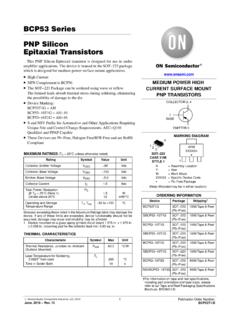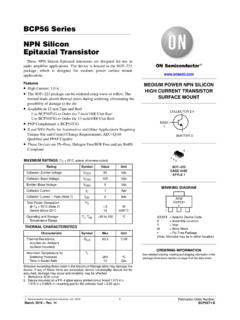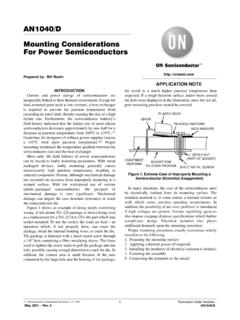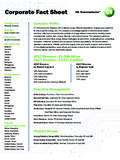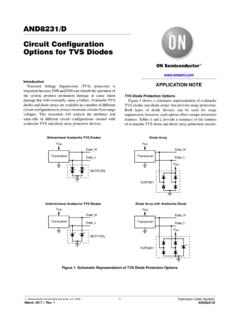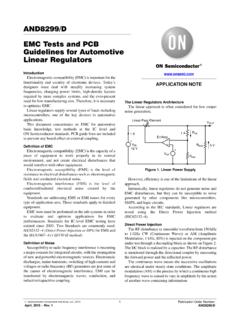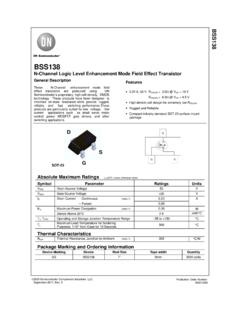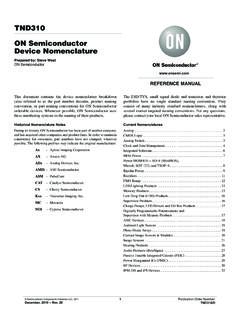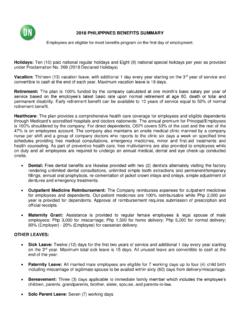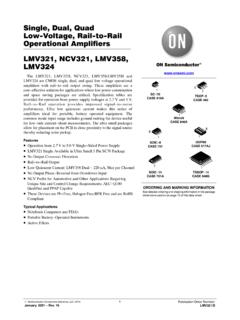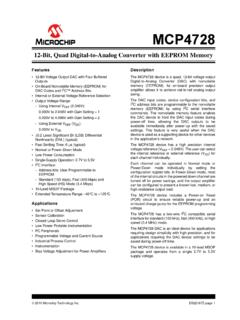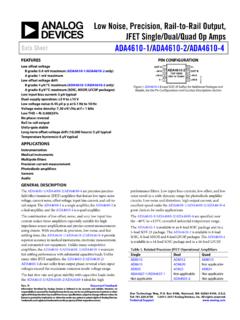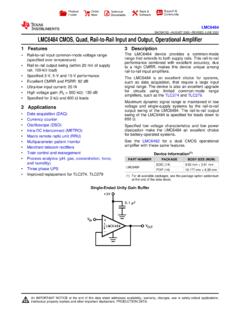Transcription of MC33272A - Operational Amplifiers, Single Supply, High ...
1 Semiconductor Components Industries, LLC, 2013 July, 2013 Rev. 141 Publication Order Number: MC33272A /DMC33272A, MC33274A,NCV33272A, NCV33274 AOperational Amplifiers, Single Supply, High Slew Rate, Low Input Offset VoltageThe MC33272/74 series of monolithic Operational amplifiers are quality fabricated with innovative Bipolar design concepts. This dual and quad Operational amplifier series incorporates Bipolar inputs along with a patented Zip R Trim element for input offset voltage reduction. The MC33272/74 series of Operational amplifiers exhibits low input offset voltage and high gain bandwidth product. Dual doublet frequency compensation is used to increase the slew rate while maintaining low input noise characteristics. Its all NPN output stage exhibits no deadband crossover distortion, large output voltage swing, and an excellent phase and gain margin.
2 It also provides a low open loop high frequency output impedance with symmetrical source and sink AC frequency Input offset voltage Trimmed to 100 mV (Typ) Low Input Bias Current: 300 nA Low Input Offset Current: nA High Input Resistance: 16 MW Low Noise: 18 nV/ Hz @ kHz High Gain Bandwidth Product: 24 MHz @ 100 kHz High Slew Rate: 10 V/ms Power Bandwidth: 160 kHz Excellent Frequency Stability Unity Gain Stable: w/Capacitance Loads to 500 pF Large Output voltage Swing: + V/ V Low Total Harmonic Distortion: Power Supply Drain Current: mA per Amplifier Single or Split Supply Operation: + V to +36 V or V to 18 V ESD Diodes Provide Added Protection to the Inputs NCV Prefix for Automotive and Other Applications RequiringUnique Site and Control Change Requirements; AEC Q100 Qualified and PPAP Capable Pb Free Packages are AvailablePDIP 8P SUFFIXCASE 626 SOIC 8D SUFFIXCASE 751 MARKINGDIAGRAMSDUALQUADPDIP 14P SUFFIXCASE 64614 SOIC 14D SUFFIXCASE 751A118MC33272 APAWLYYWWG33272 ALYWxG114MC33274 APAWLYYWWG1818114 See detailed ordering and shipping information in the packagedimensions section on page 11 of this data = A for MC33272AD/DR2= N for NCV33272 ADR2A= Assembly LocationWL, L= Wafer LotYY, Y= YearWW, W = Work WeekG or G= Pb Free PackageNCV33274 ALYWGG114114 TSSOP 14 DTB SUFFIXCASE 948G(Note.)
3 Microdot may be in either location)MC33274 AALYWGG114MC33272A, MC33274A, NCV33272A, NCV33274 CONNECTIONSCASE 626/751 DUALCASE 646/751A/948 GQUAD(Top View) VEEI nputs 1 Inputs 2 Output 2 Output 1 VCC--++12348765 Inputs 1 Output 1 VCCI nputs 2 Output 2 Output 4 Inputs 4 VEEI nputs 3 Output 3(Top View)42311234567891011121314++--+-+-MAXI MUM RATINGSR atingSymbolValueUnitSupply VoltageVCC to VEE+36 VInput Differential voltage RangeVIDRNote 1 VInput voltage RangeVIRNote 1 VOutput Short Circuit Duration (Note 2)tSCIndefinitesecMaximum Junction TemperatureTJ+150 CStorage TemperatureTstg 60 to +150 CESD Protection at Any Pin Human Body Model Machine ModelVesd2000200 VMaximum Power DissipationPDNote 2mWOperating Temperature RangeMC33272A, MC33274 ANCV33272A, NCV33274 ATA 40 to +85 40 to +125 CStresses exceeding Maximum Ratings may damage the device.
4 Maximum Ratings are stress ratings only. Functional operation above theRecommended Operating Conditions is not implied. Extended exposure to stresses above the Recommended Operating Conditions may affectdevice Either or both input voltages should not exceed VCC or Power dissipation must be considered to ensure maximum junction temperature (TJ) is not exceeded (see Figure 2). MC33272A , MC33274A, NCV33272A, NCV33274 ELECTRICAL CHARACTERISTICS (VCC = +15 V, VEE = 15 V, TA = 25 C, unless otherwise noted.)CharacteristicsFigureSymbolMinTyp MaxUnitInput offset voltage (RS = 10 W, VCM = 0 V, VO = 0 V)(VCC = +15 V, VEE = 15 V)TA = +25 CTA = 40 to +85 CTA = 40 to +125 C (NCV33272A)TA = 40 to +125 C (NCV33274A)(VCC = V, VEE = 0)TA = +25 C3|VIO| Temperature Coefficient of Input Offset VoltageRS = 10 W, VCM = 0 V, VO = 0 V, TA = 40 to +125 C3 DVIO/DT mV/ CInput Bias Current (VCM = 0 V, VO = 0 V)TA = +25 CTA = Tlow to Thigh4, 5 IIB 300 650800nAInput Offset Current (VCM = 0 V, VO = 0 V)TA = +25 CTA = Tlow to Thigh|IIO| 6580nACommon Mode Input voltage Range (DVIO = mV, VO = 0 V)TA = +25 C6 VICRVEE to (VCC )VLarge Signal voltage Gain (VO = 0 V to 10 V, RL = kW)TA = +25 CTA = Tlow to Thigh7 AVOL9086100 dBOutput voltage Swing (VID = V)(VCC = +15 V, VEE = 15 V)
5 RL = kWRL = kWRL = 10 kWRL = 10 kW(VCC = V, VEE = 0 V)RL = kWRL = kW8, 9, 1210, 11VO+VO VO+VO Mode Rejection (Vin = + V to 15 V)13 CMR80100 dBPower Supply RejectionVCC/VEE = +15 V/ 15 V, + V/ 15 V, +15 V/ V14, 15 PSR80105 dBOutput Short Circuit Current (VID = V, Output to Ground)SourceSink16 ISC+25 25+37 37 mAPower Supply Current Per Amplifier (VO = 0 V)(VCC = +15 V, VEE = 15 V)TA = +25 CTA = Tlow to Thigh(VCC = V, VEE = 0 V)TA = +25 C17 ICC MC33272A , MC33274 ATlow = 40 CThigh = +85 CNCV33272A, NCV33274A Tlow = 40 CThigh = +125 CMC33272A, MC33274A, NCV33272A, NCV33274 ELECTRICAL CHARACTERISTICS (VCC = +15 V, VEE = 15 V, TA = 25 C, unless otherwise noted.)CharacteristicsFigureSymbolMinTyp MaxUnitSlew Rate(Vin = 10 V to +10 V, RL = kW, CL = 100 pF, AV = + V)18, V/msGain Bandwidth Product (f = 100 kHz)19 GBW1724 MHzAC voltage Gain (RL = kW, VO = 0 V, f = 20 kHz)20, 21, 22 AVO 65 dBUnity Gain Bandwidth (Open Loop)BW MHzGain Margin (RL = kW, CL = 0 pF)23, 24, 26Am 12 dBPhase Margin (RL = kW, CL = 0 pF)23, 25, 26fm 55 DegChannel Separation (f = 20 Hz to 20 kHz)27CS 120 dBPower Bandwidth (VO = 20 Vpp, RL = kW, THD )BWP 160 kHzTotal Harmonic Distortion(RL = kW, f = 20 Hz to 20 kHz, VO = Vrms, AV = + )28 THD %Open Loop Output Impedance (VO = 0 V, f = MHz)29|ZO| 35 WDifferential Input Resistance (VCM = 0 V)Rin 16 MWDifferential Input Capacitance (VCM = 0 V)Cin pFEquivalent Input Noise voltage (RS = 100 W, f = kHz)
6 30en 18 nV/ Hz Equivalent Input Noise Current (f = kHz)31in pA/ Hz Vin-SectionsBCDVEE+VinVOVCC++Figure 1. Equivalent Circuit Schematic(Each Amplifier) MC33272A , MC33274A, NCV33272A, NCV33274 2. Maximum Power Dissipationversus TemperatureFigure 3. Input offset voltage versusTemperature for Typical UnitsFigure 4. Input Bias Current versusCommon Mode VoltageFigure 5. Input Bias Currentversus TemperatureFigure 6. Input Common Mode VoltageRange versus TemperatureFigure 7. Open Loop voltage Gainversus TemperatureP (MAX), MAXIMUM POWER DISSIPATION (mW)DTA, AMBIENT TEMPERATURE ( C)020406080 100120 140 160 180-60 -40 -20MC33272P & MC33274 PMC33274 DMC33272DV , INPUT offset voltage (mV)IOTA, AMBIENT TEMPERATURE ( C)-55-250255075100125 VCC = +15 VVEE = -15 VVCM = 0 V1. VIO > 0 @ 25 C2. VIO = 0 @ 25 C3.
7 VIO < 0 @ 25 C13213I , INPUT BIAS CURRENT (nA)IBVCM, COMMON MODE voltage (V) = +15 VVEE = -15 VTA = 25 CTA, AMBIENT TEMPERATURE ( C)-55-250255075100125 VCC = +15 VVEE = -15 VVCM = 0 VTA, AMBIENT TEMPERATURE ( C)V , INPUT COMMON MODE voltage RANGE (V)ICR-55-250255075100125 VEEVCCVCC = + V to +18 VVEE = V to -18 VDVIO = mVVO = 0 VTA, AMBIENT TEMPERATURE ( C)A , OPEN LOOP voltage GAIN (X kV/V)VOL-55-250255075100125 VCC = +15 VVEE = -15 VRL = kWf = 10 HzDVO = -10 V to +10 VI , INPUT BIAS CURRENT (nA) + + , MC33274A, NCV33272A, NCV33274 , OUTPUT voltage (V)ppVO, OUTPUT voltage (V)ppTA = 55 CTA = 125 CTA = 25 CTA = 25 CTA = -55 CTA = 125 CVCC = +15 VRL to VCCVEE = GndRFdbk = 100 kW Figure 8. Split Supply Output voltage Swingversus Supply VoltageFigure 9. Split Supply Output SaturationVoltage versus Load CurrentFigure 10.
8 Single Supply Output SaturationVoltage versus Load Resistance to GroundFigure 11. Single Supply Output SaturationVoltage versus Load Resistance to VCCF igure 12. Output voltage versus FrequencyFigure 13. Common Mode Rejectionversus , VEE SUPPLY voltage (V)TA = 25 CRL = 10 kWRL = , LOAD CURRENT ( mA), OUTPUT SATURATION voltage (V)satSourceTA = 125 CTA = 25 CTA = -55 k10 k100 MRL , LOAD RESISTANCE TO GROUND (kW)VCCVCC = + V to +18 VRL to GndVEE = GndTA = 55 CTA = 125 CTA = +25 CTA = -55 CGndTA = 125 k100 kRL, LOAD RESISTANCE TO VCC (W) k10 M1 0M100 kf, FREQUENCY (Hz)VCC = +15 VVEE = -15 VRL = kWAV = + = = 25 Cf, FREQUENCY (Hz) k10 k100 MCMR, COMMON MODE REJECTION (dB)TA = -55 CTA = 125 CVCC = +15 VVEE = -15 VVCM = 0 VDVCM = VVCC = + V to +18 VVEE = V to -18 V10 kSinkTA = 125 CTA = 25 CTA = -55 CV, OUTPUT SATURATION voltage (V)satV, OUTPUT SATURATION voltage (V)
9 SatVCMR = 20 LogADM-+DVCMDVOX ADMDVCMDVO403020100 VCCVCC + + -12+ + , MC33274A, NCV33272A, NCV33274 = 125 CVCC = +15 VVEE = -15 VDVCC = VTA = -55 CVCCVEEADM-++PSR = 20 LogDVODVO/ADMDVCCF igure 14. Positive Power Supply Rejectionversus FrequencyFigure 15. Negative Power Supply Rejectionversus FrequencyFigure 16. Output Short Circuit Currentversus TemperatureFigure 17. Supply Current versusSupply VoltageFigure 18. Normalized Slew Rateversus TemperatureFigure 19. Gain Bandwidth Productversus Temperaturef, FREQUENCY (Hz)+PSR, POWER SUPPLY REJECTION (dB) k10 k100 k1 .0 Mf, FREQUENCY (Hz)-PSR, POWER SUPPLY REJECTION (dB) k10 k100 MTA = 125 CDVCC = VVCC = +15 VVEE = -15 VTA = -55 CTA, AMBIENT TEMPERATURE ( C)|I |, OUTPUT SHORT CIRCUIT CURRENT (mA)SC6050403020100-55-250255075100125 SourceSinkSinkSourceVCC = +15 VVEE = -15 VVID = VRL < 100 WVCC, |VEE| , SUPPLY voltage (V)I , SUPPLY CURRENT (mA) = +125 CTA = +25 CTA = -55 CTA, AMBIENT TEMPERATURE ( C)SR, SLEW RATE (NORMALIZED) = +15 VVEE = -15 VDVin = 20 VTA, AMBIENT TEMPERATURE ( C)GBW, GAIN BANDWIDTH PRODUCT (MHz)50403020100-55-250255075100125 VCC = +15 VVEE = -15 Vf = 100 kHzRL = kWCL = 0 pFVCCVEEADM-+-PSR = 20 LogDVODVO/ADMDVEEVO100 kWDVin-+ MC33272A , MC33274A, NCV33272A, NCV33274 = 10 pFCL = 100 pFCL = 300 pFCL = 500 pFVCC = +15 VVEE = -15 V1A2A2B1 BFigure 20.
10 voltage Gain and Phaseversus FrequencyFigure 21. Gain and Phase versus FrequencyFigure 22. Open Loop voltage Gain andPhase versus FrequencyFigure 23. Open Loop Gain Margin and PhaseMargin versus Output Load CapacitanceFigure 24. Open Loop Gain Marginversus TemperatureFigure 25. Phase Margin versus Temperaturef, FREQUENCY (Hz)EXCESS PHASE (DEGREES) ,A , voltage GAIN (dB) M10 M100 MGainPhaseVCC = +15 VVEE = -15 VRL = kWTA = 25 Cf, FREQUENCY (Hz)PHASE (DEGREES) ,A , voltage GAIN (dB) M10 M100 MTA = 25 CCL = 0 pF1A - Phase VCC = 18 V, VEE = -18 V2A - Phase VCC = V, VEE = V1B - Gain VCC = 18 V, VEE = -18 V2B - Gain VCC = V, VEE = V1A2A1B2Bf, FREQUENCY (MHz)VOLEXCESS PHASE (DEGREES) 20100-10A , OPEN LOOP voltage GAIN (dB) = +15 VVEE = -15 VVout = 0 VTA = 25 C1A - Phase (RL = kW)2A - Phase (RL = kW, CL = 300 pF)1B - Gain (RL = kW)2B - Gain (RL = kW, CL = 300 pF)mCL, OUTPUT LOAD CAPACITANCE (pF)A , OPEN LOOP GAIN MARGIN (dB) , PHASE MARGIN (DEGREES) mVin-+ kWGain MarginPhase MarginVCC = +15 VVEE = -15 VVO = 0 VTA, AMBIENT TEMPERATURE ( C)
